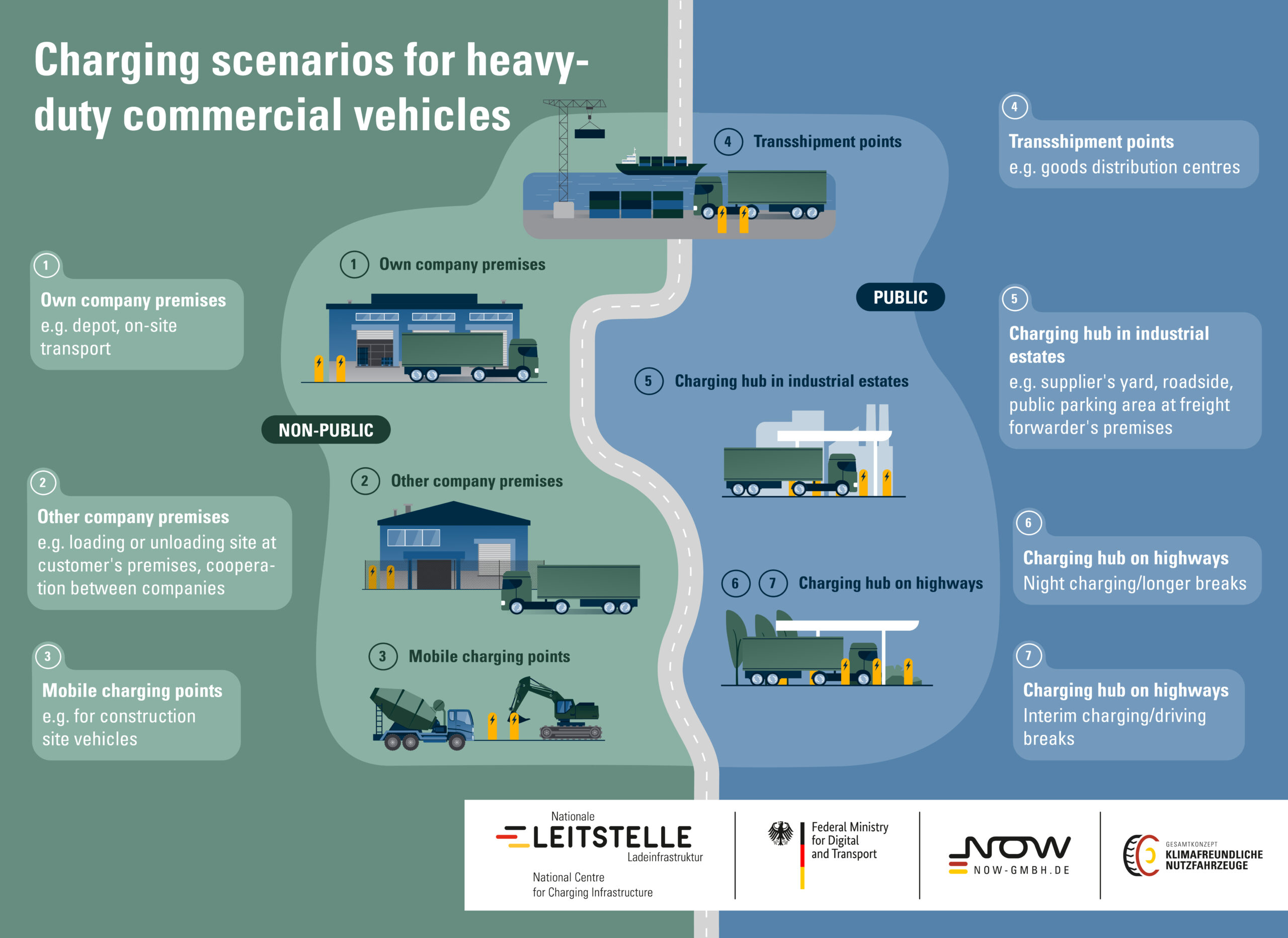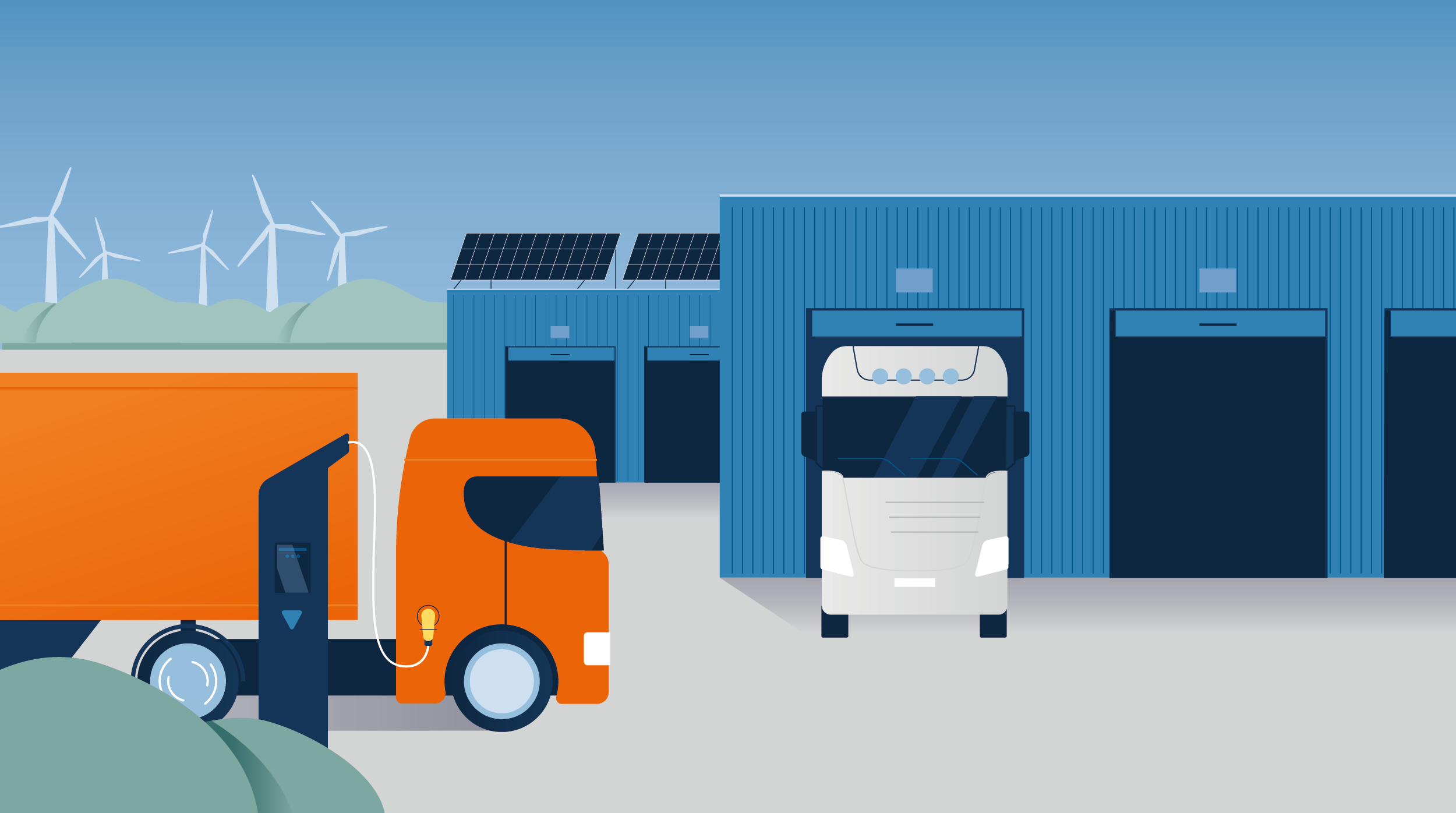Charging infrastructure for commercial vehicles

The federal government’s Climate Protection Programme 2030 specifies the goal that one third of the mileage in heavy road freight transport should be electric by 2030. The BMDV’s “Overall concept for climate-friendly commercial vehicles – With alternative drives on the way to zero-emission logistics on the road“ of 2020 shows the path to achieving these climate protection goals. It contains an integrated package of measures consisting of vehicle funding, control of infrastructure development and the creation of a targeted regulatory framework. In order to also guarantee the development of a nationwide, demand-oriented and user-friendly charging infrastructure in the truck sector, the federal government has for the first time adopted comprehensive measures for the establishment of charging infrastructure specifically for heavy commercial vehicles with the Master Plan Charging Infrastructure II. This includes, in particular, the establishment of an initial fast charging network for trucks along the long-haul routes as well as support for the development of truck charging infrastructure in depots and logistics hubs.
Charging scenarios: Where do battery-electric commercial vehicles charge?

Current projects
For this reason, NOW GmbH and the National Centre for Charging Infrastructure are involved in various projects and initiatives to create the technical, legal and economic basis together with the industry and the Federal Ministry for Digital and Transport (BMDV – Bundesministerium für Digitales und Verkehr) in order to facilitate uniform and practical planning for the installation of charging infrastructure for heavy-duty commercial vehicles. The knowledge gained will be incorporated into the centre’s planning for the expansion of the charging infrastructure.
Backcasting task force
The goal of the task force was to anticipate the development of the necessary public charging infrastructure for zero-emission e-trucks in long-haul transport. Approximately 80 representatives from a total of 40 organisations and companies took part in the six-month task force process.
The task force’s starting point was the identification of tasks and topics that need to be addressed when setting up public charging infrastructure on the motorway or in areas close to the motorway. For each topic area, the most important open questions were designated, and challenges were identified. More than 30 needs for action were derived from the challenges. Many of the needs for action have been incorporated as measures in the Master Plan Charging Infrastructure II.
A complete overview of all identified fields of action (currently in German only) can be found on the website: https://www.klimafreundliche-nutzfahrzeuge.de/task-force-backcasting .

“Easy e-truck charging” guideline
In cooperation with the stakeholders involved, the National Centre for Charging Infrastructure is developing a user journey for future truck charging based on the already published use case landscape for heavy commercial vehicles. For this purpose, a ProjektHAUS series was launched with the aim of describing the future overall system of truck charging. The ProjektHAUS series delves into the topic packages of route planning, reservation, charging process and all aspects of charging in focus workshops. The participants were selected in advance based on their expertise. They represent various sectors of the economy, such as the logistics industry or truck manufacturers. Charging point operators, associations, trade unions and scientific representatives were also involved. One outcome is the National Centre for ChargingInfrastructure’s publication “Easy e-truck charging – the user journey at public charging stations now and in 2030“, which was published (currently in German only) in June 2023.

Depot charging task force
The charging of vehicles at the depot is of major importance for the operation of electric commercial vehicles. Therefore, the aim of the depot charging task force of the Federal Ministry for Digital and Transport (BMDV), NOW GmbH and the National Centre for Charging Infrastructure, which took place within the scope of the “Overall Concept for Climate-Friendly Commercial Vehicles”, was to think ahead about the development of the necessary non-public charging infrastructure for e-trucks Approximately 60 representatives from a total of almost 40 organisations and companies took part in the six-month task force process.
During the task force process, the involved experts identified the following key challenges for the development of non-public charging infrastructure on business premises:
- Space is a scarce commodity on company premises and logistics depots.
- In view of the high electricity demand for charging e-trucks, the question arises as to how existing grid connections can be optimally used through appropriate load and charging management and whether grid connections need to be expanded.
- Most logistics companies lack experience in the energy sector.
- There is scope for interpretation in the technical definition of standards and norms at the interfaces between the vehicle, the charging infrastructure and the back end.
- New parameters must be integrated into route planning, which can lead to conflicts of objectives with previous optimisation routines and the existing flexibility in vehicle deployment.
- There is a lack of data interfaces and accessibility with regard to forthcoming different public and non-public charging locations and the desired functionalities (including reservability, authentication).
- There is regularly a dismantling obligation for the charging infrastructure at the end of the lease.
A brief overview (in German) of the depot charging task force can be found at https://www.klimafreundliche-nutzfahrzeuge.de/task-force-depotladen/
"Easy charging at the depot" guideline
The “Easy charging at the depot – guide for setting up charging infrastructure for heavy commercial vehicles“ guideline, published by the National Centre for Charging Infrastructure in November 2023, aims to help companies with truck fleets get started with electric mobility and support the transformation process towards low-emission logistics. Over three chapters, the guide explains key technical terms, provides examples of the process from planning to operating the charging infrastructure at the depot and looks at the economic aspects of the transition. The individual sections contain answers to the key questions and provide practical tips.
The guide to depot charging is also based on the findings of the Depot Charging Task Force of the BMDV, NOW GmbH and the National Centre for Charging Infrastructure, which was formed as part of the “Overall concept for climate-friendly commercial vehicles”. A total of around 60 representatives from almost 40 organisations and companies took part in the six-month task force process.
The “Easy charging at the depot” guideline is part of the “Charging Infrastructure Masterplan II”, which was adopted by the federal cabinet in October 2022 as the federal government’s roadmap for the expansion of charging infrastructure. The 68 measures in the plan are intended to accelerate the expansion of charging infrastructure.
"Easy charging at rest areas" study
To successfully use e-trucks even on long distances, not only must a demand-oriented charging network be newly established, but its connection to the electricity grid must also be thoroughly considered and planned from the very beginning. The “Easy Charging at rest areas” study focuses on questions of grid connection for e-truck charging hubs and looks at three different prototypical locations, which differ depending on the traffic volume of heavy goods vehicles. It was conducted by the ef.Ruhr energy think tank on behalf of the National Centre for Charging Infrastructure. The aim of the study is a structured preparation of essential criteria and aspects that must be taken into account with regard to the network when selecting, evaluating and planning charging hubs along the motorway network. The study examined prototype charging hubs on internationally significant traffic axes (main roads), at locations with medium traffic volumes and at previously unmanaged rest areas with lower expected demand. From forecasts of how many charging points with how much power will be needed at the three prototypical charging hubs in the coming years 2027, 2030 and 2035, the authors of the study derive specific requirements for connection to the electricity grid. The study reveals that a connection to the high-voltage grid will be required at highly frequented locations from 2035 at the latest.

Market development of climate-friendly technologies in heavy road transport
The “Cleanroom Talks” are individual discussions with one vehicle manufacturer at a time. The format gives manufacturers the opportunity to provide information in a closed environment within a framework that complies with antitrust law. In concrete terms, quantitative data on planned sales figures up to 2030 were provided by the manufacturers. This data was stored in a secure data room provided by a law firm and anonymised in aggregated format. Secondly, individual discussions were held with the manufacturers. Within the scope of a structured interview, strategic evaluation of technology options, an assessment of regulatory framework conditions and infrastructure requirements were requested.
The quantitative data and the qualitative assessments were anonymously aggregated and published in the NOW publication „Market Development of Climate-friendly Technologies in Heavy-duty Road Freight Transport“ .
The findings from the interviews serve as a basis for building the infrastructures in a targeted manner in line with the market ramp-up. The data is instrumental in determining charging infrastructure needs and developing a deployment strategy for a public charging infrastructure network.
The detailed results of the Cleanroom Talks on the “Market Development of Climate-friendly Technologies in Heavy-duty Road Freight Transport” can be found at: https://www.klimafreundliche-nutzfahrzeuge.de/marktentwicklung-klimafreundlicher-technologien-im-schweren-strassengueterverkehr/ .
Demand planning
StandortTOOL
Methodology
On the basis of the mobility and charging behaviour, the StandortTOOL models the future demand for charging points. Data on mobility, transport volumes, socio-economics, number of vehicles and scientific findings on charging behaviour are examples of data incorporated into the model. The model divides Germany into a grid consisting of grid cells with an edge length of 500 metres. The additional charging demand for each of the grid cells is indicated by the model, the results of which are represented on a map.
In addition to charging infrastructure for battery-operated vehicles, the planning of the expansion of the hydrogen refuelling station network is also possible using the StandortTOOL. Mapping the need for charging infrastructure for commercial vehicles will supplement the StandortTOOL in the future.
Further information on the methodology and the data gathered can be found here.
Application
The StandortTOOL is used in the preparation of funding calls and financing concepts. For a specific area, it shows how high the demand for additional charging points is and where the use of funding instruments is sensible.
The StandortTOOL’s publicly-accessible website shows charging infrastructure needs until 2030 nationwide. It also depicts the amount of existing charging infrastructure, already granted charging points and the infrastructural demand over the coming years. Furthermore, it offers the federal states their own, extended access in order to synchronise federal and state activities in the area of charging infrastructure.
Further information at standorttool.de
Charging technology
Alongside the CCS charging standard, the Megawatt Charging System (MCS) is regarded as the future global charging standard for heavy commercial vehicles. Most truck manufacturers will bring MCS-capable vehicles to market from 2024/2025. MCS enables significantly higher charging capacities and thus makes heavy commercial vehicles suitable for long-haul journeys. The main area of application will be public interim charging during statutory break times (45-minute break after 4.5 h driving time), but it will also enable charging in the depot for some use cases. The MCS plug can use the same communication interface as the CCS plug.
The BMDV-funded project entitled “Hochleistungsladen im Lkw-Fernverkehr” (HoLa – “High-performance charging for long-haul trucking”) is investigating megawatt charging of heavy commercial vehicles in real logistics operations. The technology and testing project is being conducted as part of the implementation of the overall concept for climate-friendly commercial vehicles. The findings are essential for the establishment of locations in long-distance transport and also form the basis for an initial charging infrastructure network.
Further information on the Hola project can be found at: https://hochleistungsladen-lkw.de/hola-en/




